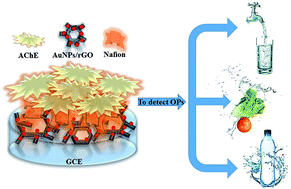A novel acetylcholinesterase biosensor based on gold nanoparticles obtained by electroless plating on three-dimensional graphene for detecting organophosphorus pesticides in water and vegetable samples
Abstract
In this study, a novel acetylcholinesterase (AChE) biosensor for the detection of organophosphorus pesticides (OPs) was developed based on a film of gold nanoparticles/three-dimensional graphene (AuNPs/rGO). This AuNPs/rGO film was prepared by the electroless plating of AuNPs on 3D graphene. The modified electrode displayed excellent electron-transfer mediation and electrical conductivity because of the synergistic effect of AuNPs and rGO. In addition, the AChE biosensor exhibited a good linear relationship at concentrations ranging from 1.0 × 10−10 to 1.0 × 10−6 g L−1. Under optimum conditions, the results showed high sensitivity of the derived biosensor for monitoring malathion and methyl parathion in water down to detection limits of 2.78 × 10−11 g L−1 and 2.17 × 10−11 g L−1, respectively. The biosensor also revealed satisfactory stability, operational repeatability and good reproducibility. When detecting methyl parathion in real water and vegetable samples, the recoveries for the AChE biosensor ranged from 94–106%, indicating that this had excellent potential for practical application. These results demonstrated that the developed electrochemical sensor shows promise as a sensing platform for OP analysis.



 Please wait while we load your content...
Please wait while we load your content...